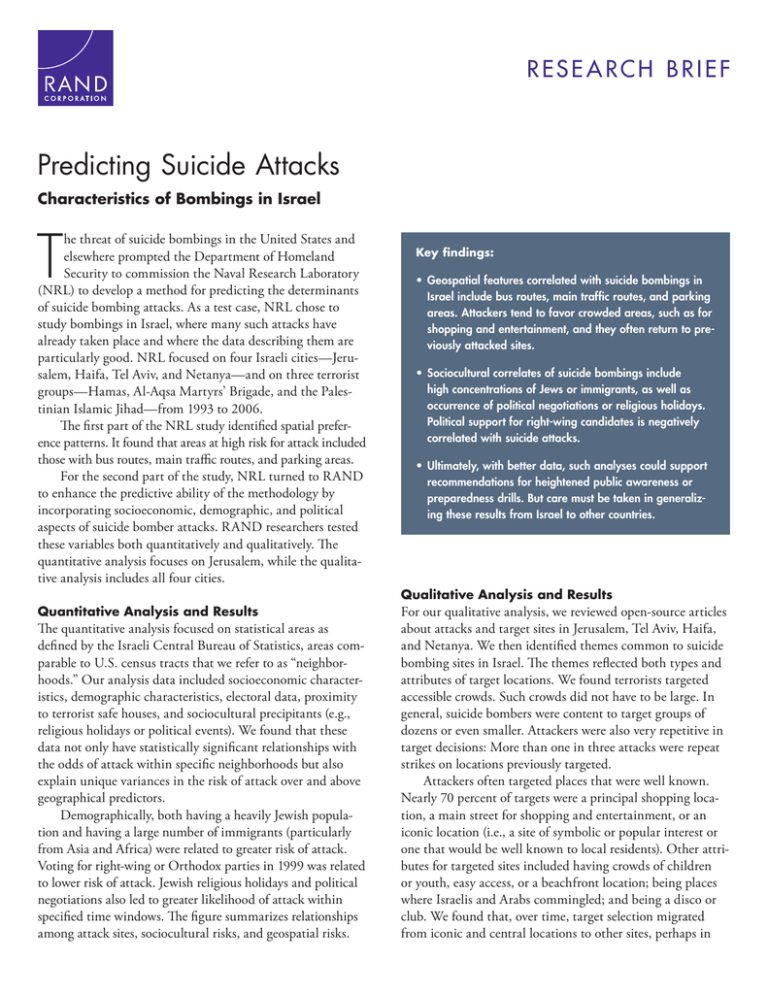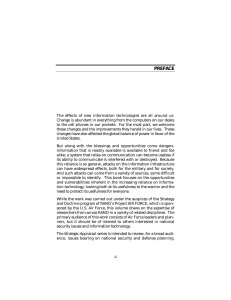T Predicting Suicide Attacks Characteristics of Bombings in Israel
advertisement

RESE ARCH BRIEF Predicting Suicide Attacks Characteristics of Bombings in Israel T he threat of suicide bombings in the United States and elsewhere prompted the Department of Homeland Security to commission the Naval Research Laboratory (NRL) to develop a method for predicting the determinants of suicide bombing attacks. As a test case, NRL chose to study bombings in Israel, where many such attacks have already taken place and where the data describing them are particularly good. NRL focused on four Israeli cities—Jerusalem, Haifa, Tel Aviv, and Netanya—and on three terrorist groups—Hamas, Al-Aqsa Martyrs’ Brigade, and the Palestinian Islamic Jihad—from 1993 to 2006. The first part of the NRL study identified spatial preference patterns. It found that areas at high risk for attack included those with bus routes, main traffic routes, and parking areas. For the second part of the study, NRL turned to RAND to enhance the predictive ability of the methodology by incorporating socioeconomic, demographic, and political aspects of suicide bomber attacks. RAND researchers tested these variables both quantitatively and qualitatively. The quantitative analysis focuses on Jerusalem, while the qualitative analysis includes all four cities. Quantitative Analysis and Results The quantitative analysis focused on statistical areas as defined by the Israeli Central Bureau of Statistics, areas comparable to U.S. census tracts that we refer to as “neighborhoods.” Our analysis data included socioeconomic characteristics, demographic characteristics, electoral data, proximity to terrorist safe houses, and sociocultural precipitants (e.g., religious holidays or political events). We found that these data not only have statistically significant relationships with the odds of attack within specific neighborhoods but also explain unique variances in the risk of attack over and above geographical predictors. Demographically, both having a heavily Jewish population and having a large number of immigrants (particularly from Asia and Africa) were related to greater risk of attack. Voting for right-wing or Orthodox parties in 1999 was related to lower risk of attack. Jewish religious holidays and political negotiations also led to greater likelihood of attack within specified time windows. The figure summarizes relationships among attack sites, sociocultural risks, and geospatial risks. Key findings: • Geospatial features correlated with suicide bombings in Israel include bus routes, main traffic routes, and parking areas. Attackers tend to favor crowded areas, such as for shopping and entertainment, and they often return to previously attacked sites. • Sociocultural correlates of suicide bombings include high concentrations of Jews or immigrants, as well as occurrence of political negotiations or religious holidays. Political support for right-wing candidates is negatively correlated with suicide attacks. • Ultimately, with better data, such analyses could support recommendations for heightened public awareness or preparedness drills. But care must be taken in generalizing these results from Israel to other countries. Qualitative Analysis and Results For our qualitative analysis, we reviewed open-source articles about attacks and target sites in Jerusalem, Tel Aviv, Haifa, and Netanya. We then identified themes common to suicide bombing sites in Israel. The themes reflected both types and attributes of target locations. We found terrorists targeted accessible crowds. Such crowds did not have to be large. In general, suicide bombers were content to target groups of dozens or even smaller. Attackers were also very repetitive in target decisions: More than one in three attacks were repeat strikes on locations previously targeted. Attackers often targeted places that were well known. Nearly 70 percent of targets were a principal shopping location, a main street for shopping and entertainment, or an iconic location (i.e., a site of symbolic or popular interest or one that would be well known to local residents). Other attributes for targeted sites included having crowds of children or youth, easy access, or a beachfront location; being places where Israelis and Arabs commingled; and being a disco or club. We found that, over time, target selection migrated from iconic and central locations to other sites, perhaps in Conclusions and Recommendations Combined Geospatial and Sociocultural Risk Map, Jerusalem 0 10 Kilometers Suicide bombing attacks Sociocultural risk > 50% Low geospatial risk (0–0.79) Medium geospatial risk (0.80–1.55) High geospatial risk (> 1.55) response to increased security at preferred sites. Nevertheless, sites attacked multiple times included the following: • in Jerusalem, the central bus station, the Jaffa Road and King George Street intersection, the Mahane Yehuda market, Ben Yehuda street (a pedestrian mall), and the French Hill bus junction • in Tel Aviv, the Neve Sha’ana market and shopping areas near the central bus station • in Netanya, Hasharon Mall entrances and immediately surrounding areas, such as bus stops. Twenty-three attacks also occurred on transportation systems, including seven attacks on the system itself, 13 attacks on locations that indirectly involved transportation, and three attacks that were premature detonations on bus lines. Some of the relationships we found, such as the attractiveness of neighborhoods with high-density Jewish populations, are obvious. Others, such as the link between immigrant neighborhoods and terrorist attacks, are less obvious and deserve further exploration. Our exploratory analyses were cross-sectional, but the sociocultural and geospatial variables and even precipitant events likely change over time. Future research using multiple years of data could determine how these changes affect suicide bombings. Outcomes in one neighborhood are also likely correlated with outcomes in nearby neighborhoods. Future analyses could explore in more depth such spatial influences. This analysis is limited to preferences of Palestinian suicide bombers. While there are some similarities between attack sites in Israel and those elsewhere, we expect there are significant differences as well. Suicide bombings in Israel took place during open hostilities between Israel and Palestinians, and Palestinian terrorist organizations have long glorified suicide operations. Neither condition is likely to apply to the United States or other Western countries. In the United States, for example, there is no comparable conflict between the government and minority groups. The United States and other countries have also had relatively few suicide attacks (September 11, 2001, being the only U.S. example). At the same time, there may well be similarities between the types of places that terrorists attack in Israel and elsewhere. Suicide bombers in Israel appear to favor places with crowds or transportation nodes, a finding that may be applicable elsewhere. The methods used to assess target preferences in Israel could be transferred elsewhere. Qualitative data analysis can be applied directly to data from elsewhere. Quantitative techniques would need to be restructured slightly, but underlying methods would still apply. Increasing the amount of available data, such as including all sites that were under surveillance, whether or not attacks succeeded, could yield more insights into what terrorists consider to be ideal targets. Ultimately, such research could help develop recommendations for heightened public awareness or preparedness drills in certain areas. This research brief describes work done for the RAND National Defense Research Institute, and RAND Justice, Infrastructure, and Environment, documented in Predicting Suicide Attacks: Integrating Spatial, Temporal, and Social Features of Terrorist Attack Targets, by Walter L. Perry, Claude Berrebi, Ryan Andrew Brown, John S. Hollywood, Amber Jaycocks, Parisa Roshan, Thomas Sullivan, and Lisa Miyashiro, MG-1246-NRL, 2013 (available at http://www.rand.org/pubs/monographs/MG1246.html). The RAND Corporation is a nonprofit research institution that helps improve policy and decisionmaking through research and analysis. RAND’s publications do not necessarily reflect the opinions of its research clients and sponsors. R® is a registered trademark. © RAND 2013 www.rand.org RB-9723-NRL (2013) CHILDREN AND FAMILIES EDUCATION AND THE ARTS The RAND Corporation is a nonprofit institution that helps improve policy and decisionmaking through research and analysis. ENERGY AND ENVIRONMENT HEALTH AND HEALTH CARE INFRASTRUCTURE AND TRANSPORTATION This electronic document was made available from www.rand.org as a public service of the RAND Corporation. INTERNATIONAL AFFAIRS LAW AND BUSINESS NATIONAL SECURITY POPULATION AND AGING PUBLIC SAFETY SCIENCE AND TECHNOLOGY TERRORISM AND HOMELAND SECURITY Support RAND Browse Reports & Bookstore Make a charitable contribution For More Information Visit RAND at www.rand.org Explore the RAND Corporation View document details Research Brief This product is part of the RAND Corporation research brief series. RAND research briefs present policy-oriented summaries of individual published, peer-reviewed documents or of a body of published work. Limited Electronic Distribution Rights This document and trademark(s) contained herein are protected by law as indicated in a notice appearing later in this work. This electronic representation of RAND intellectual property is provided for noncommercial use only. Unauthorized posting of RAND electronic documents to a non-RAND website is prohibited. RAND electronic documents are protected under copyright law. Permission is required from RAND to reproduce, or reuse in another form, any of our research documents for commercial use. For information on reprint and linking permissions, please see RAND Permissions.




